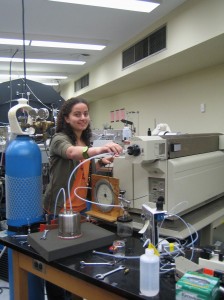We use a 9 m3smog chamber to study the production of particles from the oxidation of selected hydrocarbons. In a typical experiment we put the target hydrocarbon into the chamber with isopropyl nitrite (to make HO radicals) and NO. When we illuminate the chamber, HO radicals i nitiate the oxidation. We measure the target hydrocarbon concentration, the total hydrocarbon concentration, ozone and NO concentrations, and the size distribution of the particles produced. The photograph shows the smog chamber and some of the equipment used to do the analyses. A gas chromatograph with a flame ionization detector is used to measure the hydrocarbon concentration and the differential mobility analyser selects particles by size so they can be counted with a condensation particle counter.
nitiate the oxidation. We measure the target hydrocarbon concentration, the total hydrocarbon concentration, ozone and NO concentrations, and the size distribution of the particles produced. The photograph shows the smog chamber and some of the equipment used to do the analyses. A gas chromatograph with a flame ionization detector is used to measure the hydrocarbon concentration and the differential mobility analyser selects particles by size so they can be counted with a condensation particle counter.
We also collect samples of the particulate matter on filters for off-line analysis.
Hydrocarbons in the atmosphere undergo hydroxyl radical initiated photo-oxidation. These reactions are complex following many pathways resulting in a diverse mixture of organic products, many remaining unidentified. Depending on their vapour pressure these products may be found in the gas phase and/or particle phase. Particles have been linked to having adverse effects on climate (ex. reduced visibility) and human health therefore making knowledge regarding their composition extremely valuable. It is the chemical composition of these organic products that is the focus of this research. Two systems are used to generate the products of interest: an 8m3 smog chamber and a 3 L flow reactor. The reagents used include the hydrocarbon of interest, isopropyl nitrite as the hydroxyl radical source and NO to suppress ozone formation. The products arising from both systems are analyzed with an atmospheric pressure chemical ionization triple quadrupole mass spectrometer.
We are currently using the York University smog chamber to investigate the products formed via hydroxyl radical initiated photo-oxidation of beta-Pinene under varied NOx concentrations with the desire to improve the current understanding of product composition and formation mechanisms. The size of the chamber allows for time evolution experiments, which will contribute to the understanding of how products evolve with time individually and in relation to the other products.
The flow reactor reactor system allows for the continuous and consistent production of gas and particle products of hydrocarbon photo-oxidation. The flow reactor has recently been coupled with a Counter Flow Diffusion Denuder that facilitates online gas/particle separation. Particle and gas phase composition studies of m-xylene and other atmospherically relevant hydrocarbons are on going.
We have a collaboration with the Ontario Ministry of the Environment, which has allowed us to obtain the TAGA 6000 triple quadrupole mass spectrometer, shown in the photograph. We will soon be sampling the gases and particles from these reactions into this instrument to improve the on-line measurement capability of organic compounds.
